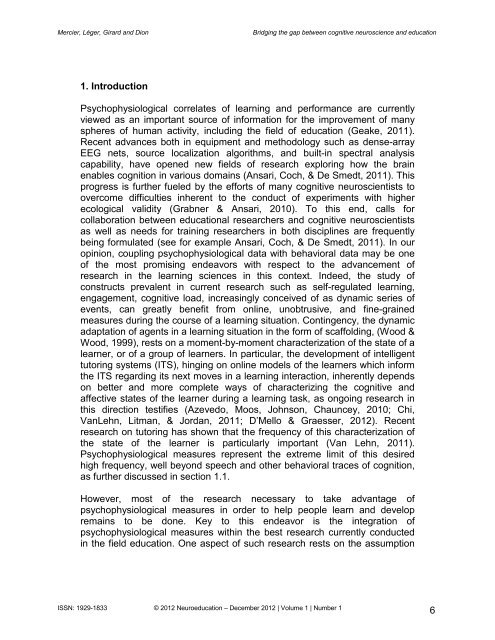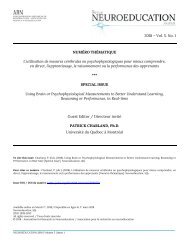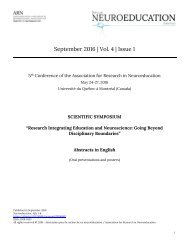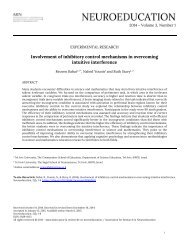Neuroeducation_2012_vol-1_no-1_full
Neuroeducation journal - Volume 1, Issue 1 (2012) - 144 pages
Neuroeducation journal - Volume 1, Issue 1 (2012) - 144 pages
You also want an ePaper? Increase the reach of your titles
YUMPU automatically turns print PDFs into web optimized ePapers that Google loves.
Mercier, Léger, Girard and Dion<br />
Bridging the gap between cognitive neuroscience and education<br />
1. Introduction<br />
Psychophysiological correlates of learning and performance are currently<br />
viewed as an important source of information for the improvement of many<br />
spheres of human activity, including the field of education (Geake, 2011).<br />
Recent advances both in equipment and methodology such as dense-array<br />
EEG nets, source localization algorithms, and built-in spectral analysis<br />
capability, have opened new fields of research exploring how the brain<br />
enables cognition in various domains (Ansari, Coch, & De Smedt, 2011). This<br />
progress is further fueled by the efforts of many cognitive neuroscientists to<br />
overcome difficulties inherent to the conduct of experiments with higher<br />
ecological validity (Grabner & Ansari, 2010). To this end, calls for<br />
collaboration between educational researchers and cognitive neuroscientists<br />
as well as needs for training researchers in both disciplines are frequently<br />
being formulated (see for example Ansari, Coch, & De Smedt, 2011). In our<br />
opinion, coupling psychophysiological data with behavioral data may be one<br />
of the most promising endeavors with respect to the advancement of<br />
research in the learning sciences in this context. Indeed, the study of<br />
constructs prevalent in current research such as self-regulated learning,<br />
engagement, cognitive load, increasingly conceived of as dynamic series of<br />
events, can greatly benefit from online, u<strong>no</strong>btrusive, and fine-grained<br />
measures during the course of a learning situation. Contingency, the dynamic<br />
adaptation of agents in a learning situation in the form of scaffolding, (Wood &<br />
Wood, 1999), rests on a moment-by-moment characterization of the state of a<br />
learner, or of a group of learners. In particular, the development of intelligent<br />
tutoring systems (ITS), hinging on online models of the learners which inform<br />
the ITS regarding its next moves in a learning interaction, inherently depends<br />
on better and more complete ways of characterizing the cognitive and<br />
affective states of the learner during a learning task, as ongoing research in<br />
this direction testifies (Azevedo, Moos, Johnson, Chauncey, 2010; Chi,<br />
VanLehn, Litman, & Jordan, 2011; D’Mello & Graesser, <strong>2012</strong>). Recent<br />
research on tutoring has shown that the frequency of this characterization of<br />
the state of the learner is particularly important (Van Lehn, 2011).<br />
Psychophysiological measures represent the extreme limit of this desired<br />
high frequency, well beyond speech and other behavioral traces of cognition,<br />
as further discussed in section 1.1.<br />
However, most of the research necessary to take advantage of<br />
psychophysiological measures in order to help people learn and develop<br />
remains to be done. Key to this endeavor is the integration of<br />
psychophysiological measures within the best research currently conducted<br />
in the field education. One aspect of such research rests on the assumption<br />
ISSN: 1929-1833 © <strong>2012</strong> <strong>Neuroeducation</strong> – December <strong>2012</strong> | Volume 1 | Number 1<br />
6








